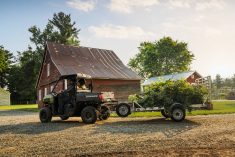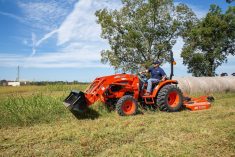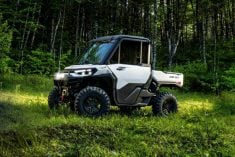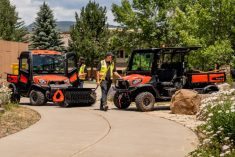At Grainews, we’re no strangers to doing practical equipment evaluations. Over the years, we’ve put a host of machines through tests that measure how well they can perform the typical work they’d be put to on farms. This year, we were at it again. We took a group of side-by-side UTVs and put them through some of the toughest evaluations we’ve ever done on this type of equipment.
The test group this year included a Kubota Sidekick RTV-XG850, a Bobcat UV34, a Mahindra mPact XTV 1000 S and a Can Am Defender PRO XT.
Read Also
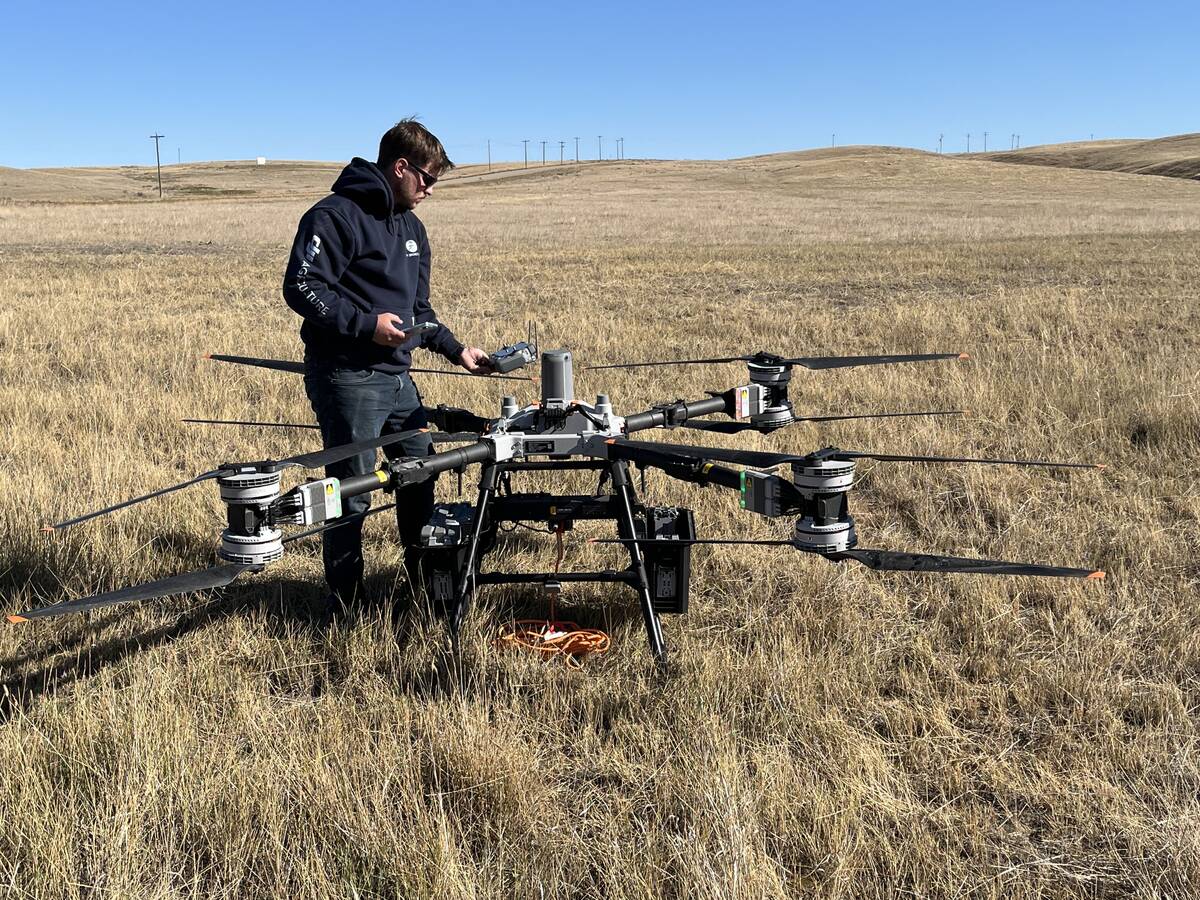
Farm-facing drone does the heavy lifting
Canadian distributor DJI Agriculture unveils its AGRAS T100 drone to western Canada’s producers for greater efficiencies in spraying and granular spreading in fields.
In our evaluations, we looked at maneuverability, general performance, load carrying and towing capability as well as overall design. As you might expect, every machine had its unique advantages and disadvantages. Here’s what we found after putting each machine through the same series of tests and evaluation.
Kubota Sidekick RTV-XG850
Relatively recent additions to Kubota’s RTV line are the X models, which include the diesel X900 and gas-powered Sidekick XG850. We tested the XG850. We’ve looked at Kubota’s other RTV models before and found them to be capable workhorses, but they didn’t fit into the sport or performance category at all, and if you want a UTV that is also a little fun to drive, well, the older RTV models wouldn’t be your first choice for that. The Sidekick, on the other hand, could be.
The Sidekick comes out as a kind of hybrid. Our testing showed this machine to be a capable farm worker, but it had a sporty side to it as well. Hats off to Kubota for injecting some fun factor into its UTV lineup.

Its 48 horsepower, 851 cc engine gives the Sidekick reasonably impressive acceleration. We didn’t get a measure of its maximum speed, suffice it to say based on our experience running through a farm field, it will likely give you all the speed you want. And it will still offer good handling characteristics along with that.
Overall, the Kubota engine provided a decent amount of torque, but we certainly made it work when climbing some of the steeper uphill sections of the test course.
The two-cylinder engine routes power through a two-range CVT transmission using a centrifugal clutch design that is typical across most other brands in the UTV world, but it’s unlike the other RTV Kubotas that use a hydrostatic drive. That’s what really sets the Sidekick XG850 apart from its orange brothers when it comes to sporty performance.
This year’s test route included some of the most challenging terrain for the unladen evaluations. The Sidekick ran through the route pretty easily, navigating tight turns and easing through tight spots without any jerky acceleration at low throttle. On steep downgrades, there was some noticeable engine braking to hold back the machine, but we still needed to brake on the more vertical sections.
Underbody clearance is just shy of 10 inches (24.9 centimetres) and it allowed us to ford shallow stream crossings with ease.
The two-to-four-wheel drive selector and the rear differential lock are simple manual controls that have a nice positive feel to them. It was the only one of the four test vehicles that didn’t use electronic switches for these functions, but the manual controls give the Sidekick a kind of classic off-road-vehicle feel that we liked.
The Sidekick gets a 1,435-pound (651 kilogram) payload rating. With two passengers up front and a 500-pound (226 kilogram) load in the box, the Sidekick didn’t flinch. It powered up moderate grades and accelerated smoothly even with the extra load. Towing an 850-pound (385 kilogram) trailer, which was well below its 2,000-pound (907 kilogram) rating, as well as carrying two passengers, it still performed well over moderate trail conditions. The suspension system handled those loads well.
Of course, one limiting factor to payload capacity on the Sidekick is the 40.5 by 57.5 inch (102 x 146 cm) steel box. The pallet holding our test load of bricks just barely fit in, but that sort of small cargo box with short sides is a typical limitation on most regular UTVs. The tailgate latch design was a favourite with the test drivers as it closed with just a simple push.
Our test Sidekick had an enclosed cab, but no air conditioning. Testing days were extremely hot, but being able to fully roll down the automotive-style door windows helped keep it reasonably comfortable inside, and the sound level was reasonable too. The exterior cab door handles were a favourite with testers as well, and they’d be easy to open even with thick gloves in cold weather. The seats are basic but adequate, and the controls fall easily to hand.
Overall, the Sidekick left us with a favourable impression. With this machine, Kubota has upped its game in the UTV segment with a good all-round and capable machine.
Bobcat UV34
This was the first time we’ve been able to get our hands on a Bobcat brand UTV. There is very little in the way of fancy graphics on it. Overall, it has a utilitarian feel, which really seems to be what the Bobcat is all about: a practical machine designed to get jobs done.
But don’t think the Bobcat is lacking in acceleration or handling. It performed well on our test course — with it’s twin-cylinder 1,000 cc gas engine putting out just under 40 horsepower, it delivered that power and performance well.

Its cargo bed is rated for 1,250 pounds (566 kilograms). Our 500-pound (226 kilogram) load barely tested the suspension. Fully loaded, the Bobcat sat up well, even with two people up front. There was very little noticeable difference in performance carrying that load when compared to the unladen test.
Its total load capacity rating is a respectable 1,900 pounds (861 kilograms).
Unfortunately, the Bobcat arrived late in our testing schedule due to a logistics problem, and by then our test trailer was no longer available, so we couldn’t evaluate its towing performance. However, based on its load carrying ability, we estimate it would have performed well there too.
Up front in the passenger compartment, the Bobcat uses a 60-40 split bench seat design. It’s basic, but comfortable. The passenger side bottom cushion tilts up to allow a large area of free floor space. There is a small storage compartment under there as well. It is pretty small, though, with tray slots that look like they were designed for pens and pencils and a smartphone.
There are also storage compartments under the dash. Most of them are quite small and shallow. Anything put in them seemed likely to want to fall out. The largest compartment could easily hold items securely, but there was a remarkably small space to reach in and get anything. That made those compartments seem like a bit of an afterthought.
The Bobcat also comes spec’d out with 75 amps of electrical output to help run equipment, such as a snow blade. And its cargo box was a little larger than the Kubota and Mahindra, which gave a bit more room for a load.
Overall, the Bobcat performed well, but as usual there were a couple of small things we didn’t care for. First, there is a whining sound from the transmission at start off and when stopping. We also noticed it during demands for higher engine torque at lower throttle. It was just a little annoying.
Second, the tailgate latch design is similar to that on a pickup truck, which we liked. But the gate on our model didn’t seem to want to open easily, often requiring two hands on the latch to get it to release. The box and tailgate are molded plastic as is the tailgate latch. We wondered if struggling with the sticky latch would eventually cause it to break over time.
Mahindra mPact XTV 1000 S
When it comes to the Mahindra, we first need to mention that the test model delivered to us wasn’t new. We ended up with a machine a couple of model years old. So, we can’t be exactly certain of the specifications or whether or not the things we noticed on our evaluation are still relevant to current production models. Also, our particular test machine had visible wear and tear. For example, we couldn’t open the front windshield to improve airflow in the cab because the hinges and one latch were broken. We kept it closed and crossed our fingers it wouldn’t fall out.
The Mahindra was the only diesel in our test group. Not surprisingly, when sitting in the cab, it was the noisiest machine to operate. It also seemed to run at consistently higher r.p.m., which contributed to the higher noise level as well.

We rated its acceleration as fair compared to the more responsive gas models in the lineup. It would, however, eventually get there and moved through our high-speed test area at a respectable pace. On downhill portions of the test track, the Mahindra lacked any engine braking, allowing the machine to run away with very little resistance. Therefore, we had to use the brakes more often on this machine than on the others while navigating the test course.
The controls are electric. All switches are mounted inline on the dash in a convenient location, including the four-wheel drive selector. This machine also has electric differential lock, which really helped improve traction. On the steep hillclimb and muddy portions of the course, the little diesel delivered adequate power to keep it moving along nicely.
We didn’t really care for the cab, which had only horizontal sliding side windows. They didn’t open very far to allow for much airflow in the non-air-conditioned cab on a hot day. And being unable to open the broken windshield, test operators suffered a little in the heat. The doors were full-length glass, and that gave the operator a terrific view around the machine. The exterior door handles were quite small, though. In cold weather, when wearing gloves or mitts, they would be awkward to access.
We did like the seats, though. In fact, they were the nicest and most comfortable of all the test machines.
The Mahindra did okay on the towing portion of the evaluation, handling an 850-pound (385 kilogram) trailer and load without too much difficulty, although it did create a noticeable load. However, when we tried to load our standard 500-pound (226 kilogram) cargo into the box, the suspension nearly bottomed out. It was clear that much weight was just too much for the machine, so we withdrew it from that portion of the evaluation. This model also had a hydraulic tilt bed, which would be very handy for dumping out loads; however, without the ability to handle much weight, it wasn’t as much of an advantage as we expected it to be.
Our final conclusion on the Mahindra was as a runabout carrying people and tools around the farm this machine would be fine. However, we wouldn’t recommend a use significantly beyond that.
Can Am Defender PRO XT
When Can Am held an event in Texas to introduce the new long-box Defender PRO XT to the media in the summer of 2019, Grainews was there. We had a chance to challenge the newest Defender in the rough Texas terrain, and were suitably impressed. When we learned the new Defender would be part of our UTV evaluation this year, we had high expectations. However, we wondered how it would do on the really tight course we set up.
There was no need for concern as it turned out. Despite its much longer wheelbase than any other machine in the evaluation group, the Defender proved it could be nearly as nimble as the others. It handled the tightest turns with impressive ease for its size. And its 13 inches of ground clearance was as good or better than any other machine we had.

The Defender has a 976 cc gas engine that is rated at 82 horsepower, much higher — nearly double, in fact — than the others in the group, and those extra ponies were certainly noticeable in the hillclimb and towing portions of the test. The Defender just eased its way up the steepest incline on the course at low throttle, while the same hill demanded a pretty full accounting of the power available in the others to make it up the grade.
The Defender PRO XT has a rated cargo capacity of 1,000 pounds or 453 kilograms (total payload of 1,700 pounds or 771 kilograms), but we found out at the Texas event that Can Am was pretty conservative when assigning those numbers. A full 1,000-pound load in the box on a rugged off-road course at that event was child’s play for the Defender. Our 500-pound (226 kilogram) load this time had virtually no effect on its performance compared to the unladen tests. Ditto with pulling our 850-pound trailer around, which is just what we expected.
When it comes to storage capacity, the Defender PRO XT is the hands-down winner. There are storage compartments in the cab and a complete under-bed compartment accessible from either side.
The engine in the Defender PRO XT is at the rear, meaning it’s much farther away from the cab than the engine on any of the others, so it’s no surprise this machine is one of the quietest we’ve driven. And with the new design, Can Am has taken other intentional steps to keep noise down, like wrapping much of the exhaust system to muffle the sound.
Due to its size, the Defender feels stable and smooth when driving it. There wasn’t much to criticize about it — but we did find something. The tailgate latches are strong and offer a firm hold, but doing them up is a bit of a clunky operation. We joked that you could easily catch your finger in it if you weren’t careful. And sure enough, before the test was over our Defender bit at least one finger.
Overall, the Defender PRO XT gets a very big two thumbs up. It’s a capable machine that can handle a lot. However, it does come with a premium price tag. MSRP starts at $24,999.




